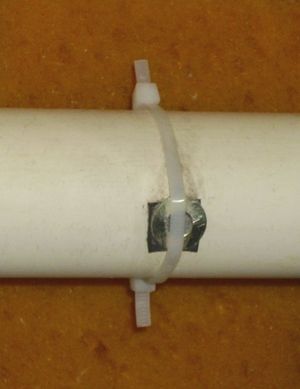Unblock a Drain
There are many ways to unblock drains. Always act before the blockage is total, as a total block makes getting chemicals to the blockage difficult to impractical.
Boiling water
Not the most effective, but will sometimes unblock fat blockages. May be tried if nothing else is to hand. Fat dissolving chemicals should then be used to clear the drain properly.
Chemicals
Sulphuric acid
Eats organic material, eg turds, paper.
- Dont't mix acid with alkali.
- Keep strong acids off chromework.
Hydrochloric acid
Eats organic material. More aggressive than sulphuric acid. A relatively high risk chemical.
30% hydrochloric acid is sold as brick acid. Some patio cleaners contain HCl.
- Never mix a strong acid with an alkali.
- Never mix acid with bleach
- Keep strong acids off chromework.
Caustic soda
Caustic eats fats, which are the most common blocker of kitchen sinks. Boiling caustic is much faster than cold caustic.
Caustic is a high risk chemical. It burns skin and can cause serious eye damage. If you get any at all in your eye, it is important to seek treatment urgently. Delay in treatment (it doesn't hurt) generally results in serious irreversible damage.
Preparing boiling caustic solution sprays strong alkali droplets, and thorough eye protection is essential.
- Caustic soda is a strong alkali.
- Never mix a strong alkali with an acid.
Bio-enzymes
These eat biological matter, but may take a very long time to do so.
Mechanical
Rod
Very effective mechanical unblocker. One of the more bulky and expensive pieces of equipment.
Metal tape
A reel of flexible metal strip or tape makes a low cost & physically small rodding device. Also sold in rotating containers for greater effectiveness.
Wire
2mm Iron wire is enough to remove many types of blockage. Cost is minimal, and it is already to hand in many cases. 1mm wire is no use for this.
An advantage of iron wire is it can be fed in through a 5mm hole.
Wire does not generally clear a drain fully, but makes a passageway for water. the blockage should be fully cleared afterwards with a suitable chemical.
Note that 2mm wire has minimal ability to go round corners, so is only good for short length rodding.
Plunger
Block all other airholes, eg overflow. Push plunger down gently but firmly, and pull up with force. Good for sinks where the blockage is an accumulation of small pieces, eg food.
Hose
Insert hose down drain. Block all holes with towel. Turn hose on full blast. Prepare to get wet and make a mess. Good for all soft blockages.
Pressure Washer
Can unblock drains, but very messy, and unblocking sewage creates a health hazard. In the latter case full splash protection is desirable!
Suited to outdoor blockages.
Curtain Wire
Curtain wire may be used for clearing blockages close to access points. A metal tape tool is better, with much greater reach.
Filter cleaning points
Plugholes
Some sink/basin plugholes have a built in strainer, sometimes this just needs to be lifted out and cleaned.
Traps
Waste traps fitted under sinks, basins, baths and showers can be disassembled to empty the accumulated crud, and allow rodding access to the pipe. There are a few different styles of trap, but all unscrew by hand, or if stiff with gentle use of a wrench.
Rodding Access points
Rodding eyes
Drain covers
Open pipe ends
Re-assemblable joints
A lot of plumbing joints can be disassembled and reassembled. Types include compression and some pushfit joints. This is impossible though with solvent welded plumbing.
Drilled hole
A 5mm hole allows a steel wire to pass inside the pipe. This is useful for solvent weld pipework with no means of access. A 5mm hole is drilled, and capped after use with either
- a piece of plastic pipe and some pipe weld solvent, or
- a piece of rubber, a bent washer and a cable tie
